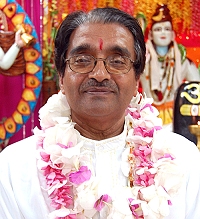From a satsang with Paramacharya of SWAHA, H.H. Pt. Hardeo Persad
The auspicious month of Shraavan, the fifth month of the Hindu calendar, will commence on July 22 and extend until August 19, 2024. This sacred period is particularly revered for the worship of Lord Shiva, with devotees intensifying their devotions to seek divine blessings and spiritual growth.
From a mythological perspective, Shraavan holds profound significance. It is believed that Parvati Devi performed penance throughout this month to win Lord Shiva’s hand in marriage. Pleased with her unwavering devotion, Lord Shiva granted her wish. This tale underscores the transformative power of sincere and constant devotion, teaching that through dedicated worship of Lord Shiva, a devotee can align with the Supreme Being, rediscovering their inherent divinity.
Additionally, Shraavan is celebrated for Lord Shiva’s heroic act of saving the universe from destruction through the deadly poison that emerged during the churning of the ocean by the Devtas and Raakshasas. Symbolically, Lord Shiva also eradicates the poisons in His devotees’ lives—negativity, aversions and worldly distractions. Shiva embodies auspiciousness and goodness, and represents the state of dispassion, or vairaagya, one of the essential qualities for liberation from the cycle of birth and death.
The greatest poison is materialism, which breeds conflict and discord. At life’s end, material possessions hold no value. Conscientious worship of Lord Shiva fosters spiritual dispassion, allowing devotees to transcend materialism and attain spiritual perfection, peace and ecstasy. Through tyaaga (renunciation) and dedicated spiritual practice, one can surpass the dualities of pain and pleasure, happiness and sadness, life and death. Shivaji exists within each of us as vairaagya and tyaaga, and our worship aims to awaken this internal power. Our scriptures teach, “Yatha Pinde, Tatha Brahmande”—“As it is in the microcosm, so it is in the macrocosm.” Thus, the spiritual journey must be undertaken within.
Lord Shiva, or Bhagavan Shankar, is renowned for his profound meditation, sustained over thousands of years, during which he controls the five major praan vaayu (vital airs) and the five minor ones, regulating all bodily functions. His matted locks, from which the sacred Ganga River flows, symbolise the stream of devotion that stems from self-restraint and sensory control. The damaru (drum) he carries represents rhythm, the cosmic cycle. Shivaji is the Lord of rhythm and the perfect artist; the Maheshwar sutra, or the law of creation, emanates from his damaru. All creation follows this rhythmic cycle, and our goal is to harmonise our personal rhythm with this divine cycle.
The serpent around Shiva’s neck symbolises the individual ego, which can be destructive if uncontrolled. The devotee’s aim is to transform the ego from a materialistic to a cosmic identification, aligning with Shivaji. This spiritual transformation leads to the realisation of the Supreme Self, encapsulated in the state of “Chidananda Rupaha, Shivoham, Shivoham,” recognising oneself as the embodiment of pure consciousness and bliss, as Shivaji.
As we enter the sacred month of Shraavan, let us deepen our devotion to Bhagavan Shankar. May this period guide us further along the path to enlightenment and self-realisation.



